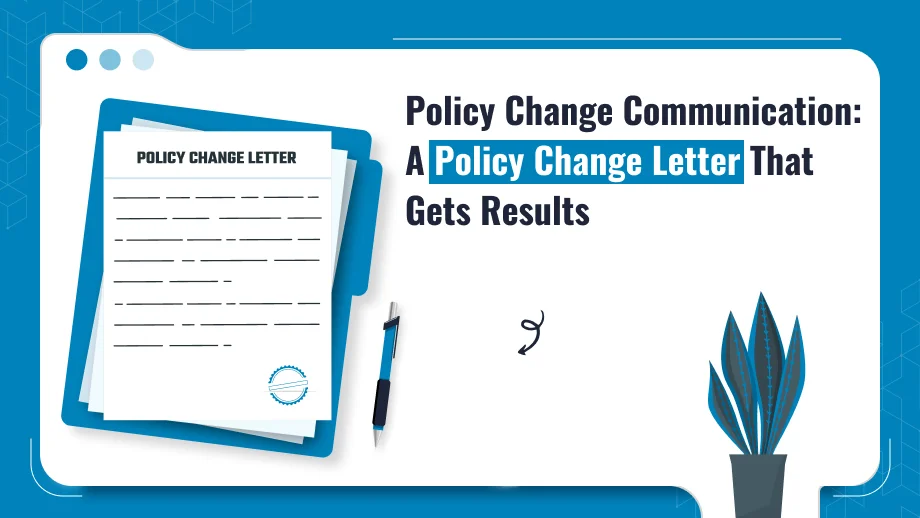Grab a chance to avail 6 Months of Performance Module for FREE
Book a free demo session & learn more about it!
-
Will customized solution for your needs
-
Empowering users with user-friendly features
-
Driving success across diverse industries, everywhere.
Grab a chance to avail 6 Months of Performance Module for FREE
Book a free demo session & learn more about it!
Superworks
Modern HR Workplace
Your Partner in the entire Employee Life Cycle
From recruitment to retirement manage every stage of employee lifecycle with ease.


Seamless onboarding & offboarding
Automated compliance & payroll
Track performance & engagement
Policy Change Communication: A Policy Change Letter That Gets Results
- Superworks
- 7 min read
- February 1, 2024

Policy changes are a common occurrence in organizations of all sizes and industries. These changes can range from implementing new HRMS software, introducing a change management policy, updating existing procedures, or launching new initiatives like a free HR toolkit for startups or an employee recognition program like Superworks.
While policy changes are necessary for the growth and adaptability of an organization, effective communication is key to ensuring that these changes are well-received and understood by employees. In this blog post, we will explore the art of crafting a persuasive Policy Change Letter that not only informs but also encourages buy-in and support from your employees.
To Know More : Navigating the Importance of Attendance: Unpacking the Attendance Policy
The Importance of Effective Policy Change Communication

Policy Change Letters serve as a crucial means of communication between an organization and its employees. A Change in policy letter plays a pivotal role in maintaining transparency, managing expectations, and ensuring smooth transitions when policies evolve. Effective policy change communication is essential for several reasons:
1. Clarity and Understanding
Policy Change Letters provide clarity about what is changing, when it will take effect, and who will be affected. This reduces confusion and ensures that all employees have a clear understanding of the changes.
2. Employee Engagement
Transparent communication fosters employee engagement and participation. When employees are informed and involved in the decision-making process, they are more likely to support and adapt to the changes.
3. Mitigating Resistance
Change often meets resistance. Addressing concerns and providing a rationale for the policy changes can help mitigate resistance and make the transition smoother.
4. Alignment with Organizational Goals
Effective communication ensures that policy changes align with the organization’s goals and objectives. It conveys how these changes will benefit both the organization and its employees.
5. Compliance and Implementation
Clear communication in Policy Change Letters encourages employees to comply with the new policies and take the necessary steps for successful implementation.
Now, let’s delve into the key elements that make changing policies successful.
Note: You can download directly from here and edit as per your need.
Key Elements of a Successful Policy Change Letter
a. Clear and Concise Introduction: The opening of your Policy Change Letter should be clear and concise. Start by stating the purpose of the communication in a straightforward manner. For example:
“Dear [Employee Name],
We are writing to inform you of an upcoming policy change that will impact our organization.”
b. Explanation of Policy Change: After the introduction, provide a detailed explanation of the policy change. This section should answer the following questions:
- What is changing?
- When will the change take effect?
- Who will be affected by the change?
Use simple language to ensure that everyone can understand the message. Avoid jargon and technical terms that may confuse readers.
c. Rationale and Benefits: Share the reasons behind the policy change. Explain why the change is necessary and what benefits it will bring to the organization, employees, and any other relevant stakeholders. Use real-world examples or statistics to support your claims. For instance:
“The implementation of our new HRMS software will streamline our HR processes, reducing administrative overhead and improving data accuracy. This will lead to more efficient operations and better employee experiences.”
d. Addressing Concerns: Anticipate potential concerns or questions that employees may have and address them in the letter. Be empathetic and provide solutions or reassurances where applicable. Acknowledge the impact on employees and show empathy for any potential challenges they may face during the transition.
“We understand that adopting new software may require some adjustment. Rest assured, we will provide comprehensive training and support to ensure a smooth transition.”
e. Call to Action: Conclude your letter with a clear call to action. Specify what you expect from the employees – whether it’s attending training sessions, complying with the new policy, or providing feedback.
“We ask for your cooperation in this transition by attending the scheduled training sessions and actively participating in the implementation process. Your feedback is also valuable to us, and we encourage you to share any concerns or suggestions.

Take action today – Read our Policy Change Letter for important updates.
Stay informed – Explore our Policy Change Letter for important updates that matter to you.
Empowering Change Through Informed Decisions. Get different kinds of HR letters to know more.
Tips for Crafting Persuasive Policy Change Letters
Writing an effective Policy Change Letter requires careful consideration and attention to detail. Here are some tips to help you create a compelling and persuasive letter:
Read more: Sick Leave Policy: A 6-Step Guide For Employers
1. Use a Professional Tone and Style
Maintain a professional tone throughout the letter. Use formal language and avoid overly casual or technical terms.
2. Keep the Letter Concise and Easy to Read
Employees may not have the time or inclination to read lengthy documents. Keep the letter concise and use short paragraphs for easy readability.
3. Use Bullet Points or Subheadings for Clarity
Break down complex information using bullet points or subheadings. This makes it easier for readers to scan and grasp the key points.
4. Provide Contact Information for Questions or Concerns
Include contact information, such as predictive hr analytics representative’s email or phone number, for employees to reach out with questions or concerns.
5. Personalize the Letter Where Possible
If possible, personalize the letter by addressing employees by their names. This adds a human touch to the communication.
6. Test the Letter with a Small Group for Feedback
Before finalizing the letter, consider testing it with a small group of employees to gather feedback and make improvements.
Ways To Policies That May Require Changes
Now that we’ve discussed the key elements and tips for crafting effective Policy Change Letters, let’s explore some examples of policies that might require changes and how to approach them:
a. HRMS Software Implementation: Implementing new HRMS software is a significant change that can greatly impact an organization. When communicating this change, emphasize the benefits it offers, such as streamlined processes, improved data accuracy, and enhanced employee self-service options. Address potential concerns about the learning curve and reassure employees about the support and training they will receive.
b. Change Management Policy: Introducing a change management policy is essential for organizations seeking to adapt to evolving circumstances. Highlight the benefits of a structured approach, including reduced resistance to change, smoother transitions, and increased adaptability. Acknowledge that change can be challenging and emphasize the organization’s commitment to supporting employees through the process.
c. Launching a Free HR Toolkit for Startups: If your organization is launching a Free HR Toolkit for startups, underline the valuable resources it provides. Mention that this initiative is aimed at empowering startups with essential tools and templates for HR processes. Encourage employees to share this resource with any startup founders or entrepreneurs they know, reinforcing the organization’s commitment to community and growth.
d. Superworks: A New Employee Recognition Program: When introducing a new employee recognition program like Superworks, highlight the positive impact it will have on employee morale, engagement, and retention. Explain how the program aligns with the organization’s values and culture. Encourage employees to embrace the program by recognizing and celebrating each other’s achievements.
Policy Change Letter Format
Conclusion
In conclusion, an effective Policy Change Letter is an indispensable tool for facilitating policy changes within organizations. They bridge the gap between management and employees, ensuring that everyone understands the rationale behind policy changes and is motivated to embrace them. By following the key elements and tips outlined in this blog post, you can craft compelling Policy Change Letters that get results, foster transparency, and promote a culture of collaboration and compliance within your organization. Remember that successful communication is not just about conveying information; it’s about engaging, inspiring, and aligning your team with the organization’s vision for the future.
Also see: official leave application format | Recognizing and rewarding employees






